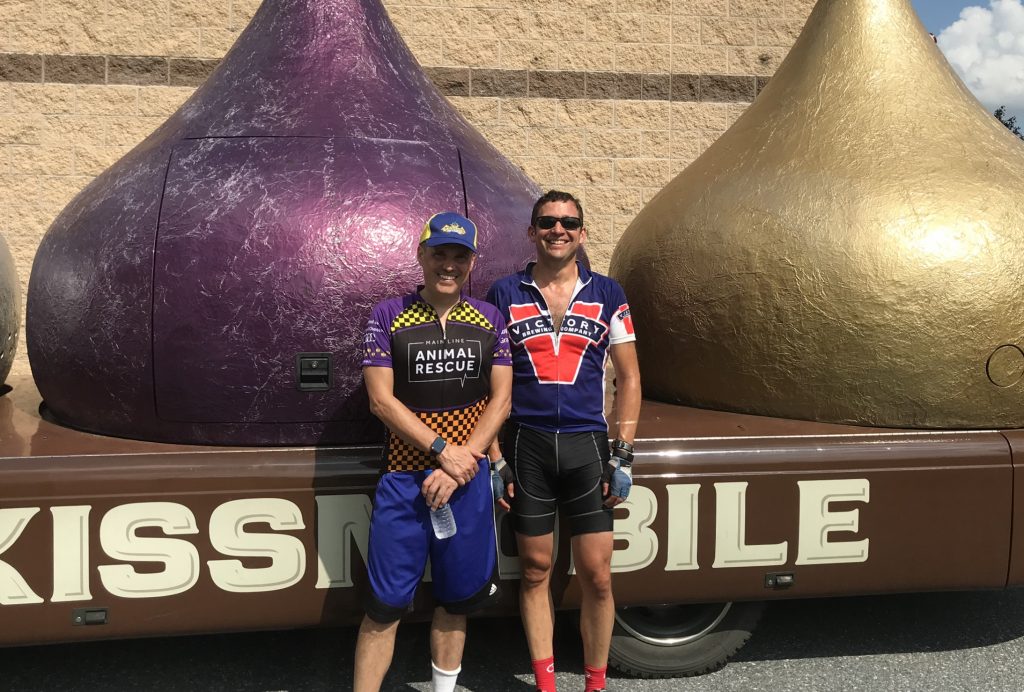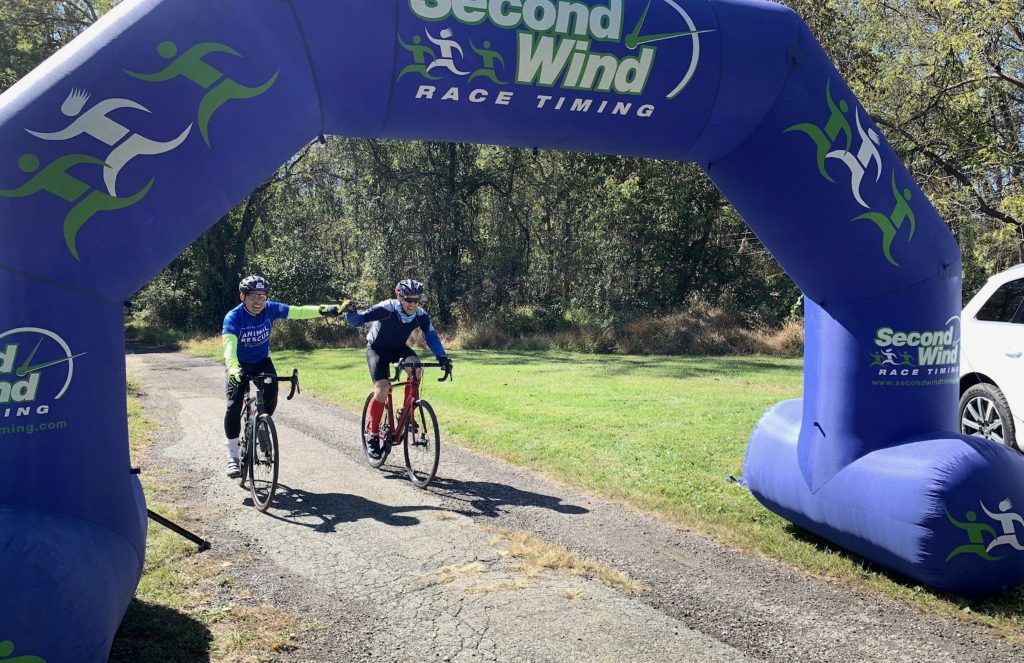I wasn’t completely sure I was going to be finishing the French Creek Iron Tour until I passed mile 80. Around mile 70 the course heads out of the wooded hills into farmland where the sun and the wind start to make you think, “how much do I really want this?” I really do enjoy cycling, and I enjoy the long rides… there is a peacefulness that you discover after a couple of hours of riding that just can’t be found on shorter rides. That said, there comes a point after five or so hours where it ceases to be fun, and I was there.
So when I did finally reach the finish line, about seven and a half hours after starting, I was pretty sure this was going to be both my first and last 100 mile bike ride. As much as I enjoy a nice, long ride, there really isn’t anything (except maybe for sleeping) that I really want to do for seven and a half hours straight. Riding a century is like climbing a mountain: you don’t particularly enjoy doing it, but you enjoy the satisfaction of having done it. As such, it doesn’t seem like there’s a whole lot of incentive, once you’ve done a century, to want to do another one. (I’ve climbed a few mountains in my life, and I can’t recall ever climbing one twice).
Never Say “Never”
Still, within just a few days of finishing the French Creek Iron Tour, I found myself reviewing the way I’d prepared … my eating, my workouts, and most of all the tapering phase in the week leading up to the ride, and I began to wonder if I really had done it right. Specifically, I was surprised during the century that I didn’t feel a bit stronger early on. Some fatigue started to set in around mile 40 that I really didn’t expect until mile 60 or so, and even though I had done several rides longer than a metric century, I felt more tired at the 60 – 80 mile distances than I thought I would be.
Each time I set out to do a ride that is longer than the previous one I had trouble knowing how to prepare because I had no frame of reference to tell me whether I should be doing more or less of this or that. Even when I could call upon similar experiences, there usually weren’t enough of them that I could make any real conclusions. Still, now I had a century under my belt, and I began to wonder how much easier it would be, then, to do it again.
It just so happened that a friend wanted to attempt his own first century a couple of months later, so we signed up for the Penn State Chocolate Tour (so-named for the chocolate candies on hand at the rest stops — fitting for a ride in and around Hershey, Pennsylvania). I really didn’t doubt that I’d be able to complete this one … I was still in shape from my preparation for the first century and this one was significantly less hilly.
On the Road Again
In the end, I think complacency got in the way of my great experiment. My family had a great vacation in mid-summer away from the bike and by the time I got home there were only about three weeks before the ride, so there wasn’t really a chance to build up the long rides like I did the first time around. I also frankly wasn’t as driven the second time around — it’s hard to get psyched up to do something you’re about 99% sure you can do. Still, there were some lessons learned.
The first lesson is that although the Penn State Chocolate Tour isn’t as hard as the French Creek Iron Tour, it’s still not easy. Yes, there was no point during the second ride that I considered bailing out and yes, I was able to complete it in nearly an hour less time (due to it being a fair bit flatter), but it was still over six hours in the saddle and that’s a long time to be riding. There’s no way I’d consider doing a century, even an “easy” one, without some serious preparation.
I also paid more attention to my snacks during this second ride. I generally don’t eat much on a bike ride, and if the ride’s less than a couple of hours I don’t feel like it really matters that much whether I eat or not. (Of course, I have a little more “on-board” energy reserves than a pro cyclist, if you know what I mean). After a couple of hours, though, your body is scrounging for energy in a way it’s never otherwise asked to. Well, maybe if you’re starving, but I’m not really into starving if I can help it. So this time I made a point of snacking on a fairly regular basis… I had a pack of gummies and a couple of GUs with me, and after mile 40 I ate a gummy every ten miles and had a GU somewhere around 60 and 80 miles, I don’t quite remember. This is still a lot less than the packages say I should be ingesting (maybe a third of what they recommend), but it did seem to help me keep my energy up.
The GUs were a bit of a disappointment. Their chocolate outrage is a great flavor, and I’d recommend it if you are ever frosting cupcakes. If you’re really just eating for the energy, though, it’s actually way too cloying to be pleasurable. Mandarin Orange is my new pick for when I’m actually exercising.
What they don’t tell you about finishing a Century
Finishing a century is a very satisfied feeling. You’ve been on the bike for hours and hours, and just not riding is a joy in and of itself at that point. Also, you have just spent a hopefully pleasant day riding around seeing the countryside, and if you remembered to put on the sunblock you should not be too toasty at the end. Plus, your Garmin congratulates you on exceeding 100 miles, which is pretty cool.
Lest you start to feel self-important in your accomplishment, though, there is a harsh reality check waiting for you at the end of the ride. I first experienced this at the end of the French Creek Iron Tour, when I walked my bike out to my car through an almost completely empty field, but it was rainy that day and I just wanted to get home and I didn’t give it much thought.
There are no photos of me finishing either of these centuries. The fact is, the photographers had long gone home. When I finished the Penn State Chocolate Tour the only people to greet me were the EMTs standing around the mandatory ambulance. There were no spectators, no photographers. Even the inflatable start/finish arch had been packed away. The dirty little secret of these centuries is that everyone has gone home by the time you’re finished.
And let me be clear: I completed the 100 miles (and 4400 feet of climb) in about 6.5 hours at a pace of 16 mph. Not Olympic numbers, I acknowledge, but this is by no means broom wagon territory, either. I really have no idea where I placed relative to the rest of the field, but there were plenty of people finishing after me. Nevertheless, the food was pretty much gone (I grabbed a few slices from the last pizza to save for my friend, who I regrettably dropped somewhere around mile 40, but that’s another story), the event T-shirts were gone (unless you’re an XXL, but how many XXLs are there doing the 100 mile route?) and the whole thing was pretty much already in the history books.
The problem is that these events have multiple distances (usually something like 25, 50, 65 and 100, for example) and often, if they don’t start all at the same time they start close to the same time (maybe the century riders get a 1/2 hour head start). So the bulk of the event participants have finished hours earlier, got their t-shirts and pizza, and are already home. When I finished the French Creek Iron Tour, I got my buffet lunch (they did a much better job of catering to the late (ie: century) crowd) and sat down, thinking, “Last year (when I did the 50 mile route) they had a band”. Well, they had a band this year, too, but the band was gone by the time the century riders finished. As far as the Chocolate Tour organizers were concerned, the century riders were on their own. It’s not that we are doing it for the fans, but a bottle of water and a banana at the end of the ride would be nice.

One more for the road
My last big ride of the season was the Main Line Animal Rescue Gran Fondo (a mouthful… there’s something to be said for their original name, “Handlebarks”), and I tried to apply my learnings from the centuries to my training. Due to some confusion regarding road markings (I will not point fingers, but I have photos to back up my claims… I thought to take photos the second time I passed through the Birchrunville loop) we ended up doing about 66 miles and over 5600 feet of climb, so it was on par with the Chocolate Tour in terms of effort. For this last ride, I really didn’t do any tapering (I felt after the centuries that the tapering I had done the week or so beforehand actually made me feel a little de-conditioned when the big day came). I think I took off the day before, and my rides for the week leading up were a bit more relaxed than usual, but there really wasn’t any tapering per se. In the end, I think that worked best, as I felt the most “myself” for that event. Whether that’s really the right approach if I found myself attempting something closer to the limits of what I can do, I am not so sure. Unfortunately, there’s probably no good way to find that out without actually doing more long rides, so don’t be surprised if I have more posts in the future about century (and maybe even century+) rides, as I try again to crack the code.


0 Comments